HONDA CR-Z 2013 1.G Owners Manual
Manufacturer: HONDA, Model Year: 2013, Model line: CR-Z, Model: HONDA CR-Z 2013 1.GPages: 325, PDF Size: 11.73 MB
Page 301 of 325
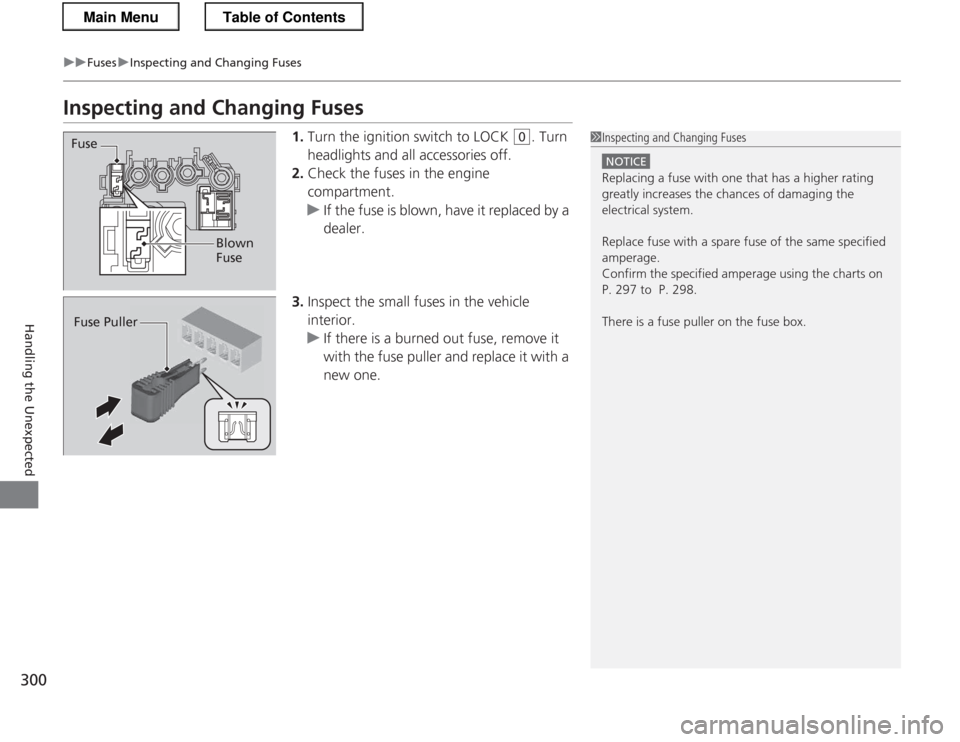
300
uuFusesuInspecting and Changing Fuses
Handling the Unexpected
Inspecting and Changing Fuses1.Turn the ignition switch to LOCK
(0 . Turn
headlights and all accessories off.
2. Check the fuses in the engine
compartment.
uIf the fuse is blown, have it replaced by a dealer.
3. Inspect the small fuses in the vehicle
interior.
uIf there is a burned out fuse, remove it with the fuse puller and replace it with a
new one.
1Inspecting and Changing Fuses
NOTICE
Replacing a fuse with one that has a higher rating
greatly increases the chances of damaging the
electrical system.
Replace fuse with a spare fuse of the same specified
amperage.
Confirm the specified amperage using the charts on
P. 297 to P. 298.
There is a fuse puller on the fuse box.
Fuse
Blown Fuse
Fuse Puller
Main MenuTable of Contents
Page 302 of 325

301
Continued
Handling the Unexpected
Emergency Towing
Call a professional towing service if you need to tow your vehicle. ■
Flat bed equipment
The operator loads your vehicle on the back of a truck.
This is the best way to transport your vehicle. ■ Wheel lift equipment
The tow truck uses two pivoting arms that go under the front tires and lift them off
the ground. The rear tires remain on the ground. This is an acceptable way to
tow your vehicle.1Emergency Towing
NOTICE
Trying to lift or tow your vehicle by the bumpers will
cause serious damage. The bumpers are not designed
to support the vehicle's weight.
NOTICE
Improper towing such as towing behind a
motorhome or other motor vehicle can damage the
transmission.
Never tow your vehicle with just a rope or chain.
It is very dangerous, since ropes or chains may shift from side to side or break.
Main MenuTable of Contents
Page 303 of 325
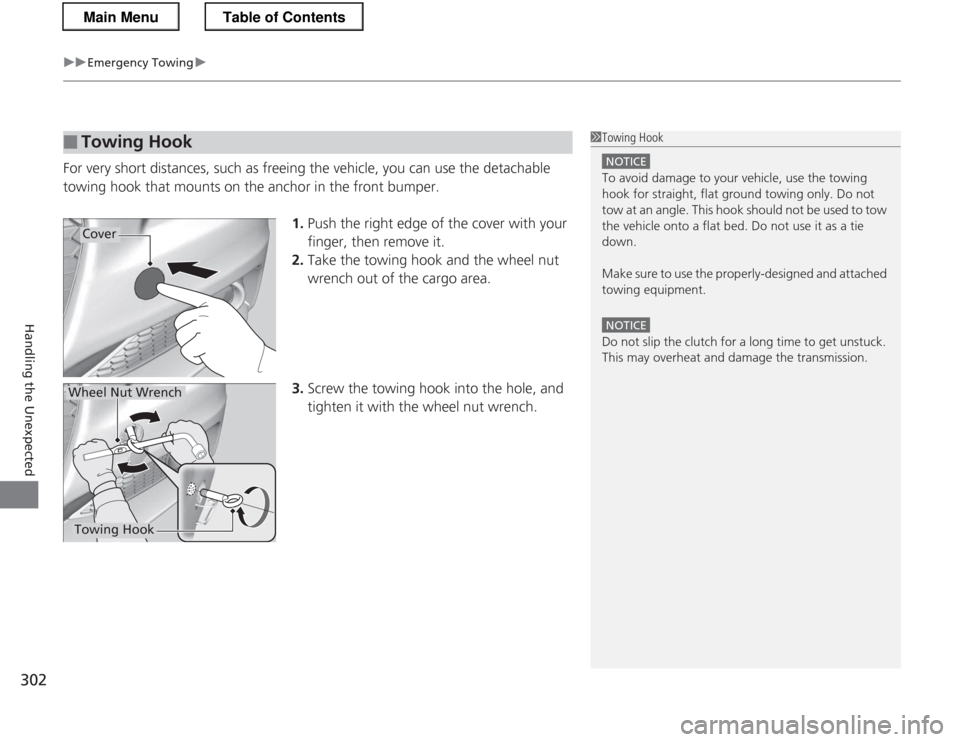
uuEmergency Towingu
302
Handling the Unexpected
For very short distances, such as freeing the vehicle, you can use the detachable
towing hook that mounts on the anchor in the front bumper.1.Push the right edge of the cover with your finger, then remove it.
2. Take the towing hook and the wheel nut
wrench out of the cargo area.
3. Screw the towing hook into the hole, and
tighten it with the wheel nut wrench.
■Towing Hook1Towing Hook
NOTICE
To avoid damage to your vehicle, use the towing hook for straight, flat ground towing only. Do not
tow at an angle. This hook should not be used to tow
the vehicle onto a flat bed. Do not use it as a tie down.
Make sure to use the properly-designed and attached
towing equipment.
NOTICE
Do not slip the clutch for a long time to get unstuck.
This may overheat and damage the transmission.
Cover
Wheel Nut Wrench
Towing Hook
Main MenuTable of Contents
Page 304 of 325

303
Handling the Unexpected
When You Cannot Open the Hatch
If you cannot open the hatch, use the following procedure.1.Remove the cover on the back of the hatch
by prying it off with a small flat-tip screwdriver.
uWrap the flat-tip screwdriver with a cloth to prevent scratches.
2. Push the release lever until the hatch
unlocks. Push the hatch up to open.
■What to Do When Unable to Open the Hatch1What to Do When Unable to Open the Hatch
After taking these steps, contact a dealer to have the
vehicle checked.
When you open the hatch from inside, make sure
there is enough space around the hatch, and it does
not hit anyone or any object.
Unlock (Open)
Main MenuTable of Contents
Page 305 of 325

304
Main MenuTable of Contents
Page 306 of 325

305
Information
This chapter includes your vehicle's specifications, locations of identification numbers, and other
information re quired by regulation.
Specifications.................................... 306
Identification Numbers Vehicle Identification Number (VIN) .. 308
Engine Number and Transmission
Number.......... ............................ 308
Devices that Emit Radio Waves ....... 309
Reporting Safety Defects ................. 310Emissions Testing
Testing of Readiness Codes.............. 311
Warranty Coverages ........................ 313
Authorized Manuals ......................... 315
Customer Service Information ......... 316
Main Menu
Page 307 of 325
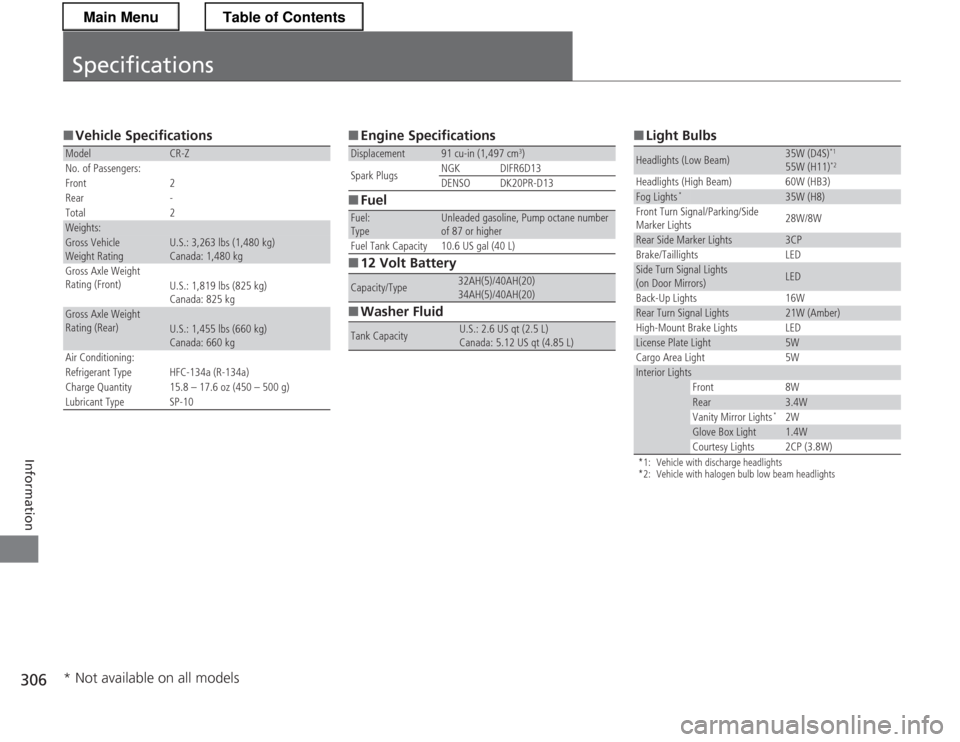
306
Information
Specifications
■Vehicle Specifications
ModelCR-Z
No. of Passengers:
Front 2
Rear -
Total 2
Weights:
Gross Vehicle
Weight Rating U.S.: 3,263 lbs (1,480 kg)
Canada: 1,480 kg
Gross Axle Weight
Rating (Front)
U.S.: 1,819 lbs (825 kg)
Canada: 825 kg
Gross Axle Weight
Rating (Rear)
U.S.: 1,455 lbs (660 kg)
Canada: 660 kg
Air Conditioning:
Refrigerant Type HFC-134a (R-134a)
Charge Quantity 15.8 – 17.6 oz (450 – 500 g)
Lubricant Type SP-10
■Engine Specifications
■Fuel
■12 Volt Battery
■Washer Fluid
Displacement91 cu-in (1,497 cm 3
)
Spark Plugs NGK DIFR6D13
DENSO DK20PR-D13
Fuel: TypeUnleaded gasoline, Pump octane number
of 87 or higher
Fuel Tank Capacity 10.6 US gal (40 L)
Capacity/Type32AH(5)/40AH(20)
34AH(5)/40AH(20)
Tank CapacityU.S.: 2.6 US qt (2.5 L)
Canada: 5.12 US qt (4.85 L)
■Light Bulbs
*1: Vehicle with discharge headlights
*2: Vehicle with halogen bulb low beam headlights
Headlights (Low Beam)35W (D4S) *1
55W (H11) *2
Headlights (High Beam) 60W (HB3)
Fog Lights *35W (H8)
Front Turn Signal/Parking/Side
Marker Lights 28W/8W
Rear Side Marker Lights3CP
Brake/Taillights LED
Side Turn Signal Lights
(on Door Mirrors)LED
Back-Up Lights 16W
Rear Turn Signal Lights21W (Amber)
High-Mount Brake Lights LED
License Plate Light5W
Cargo Area Light 5W
Interior Lights
Front 8W
Rear3.4W
Vanity Mirror Lights *
2W
Glove Box Light1.4W
Courtesy Lights 2CP (3.8W)
* Not available on all models
Main MenuTable of Contents
Page 308 of 325
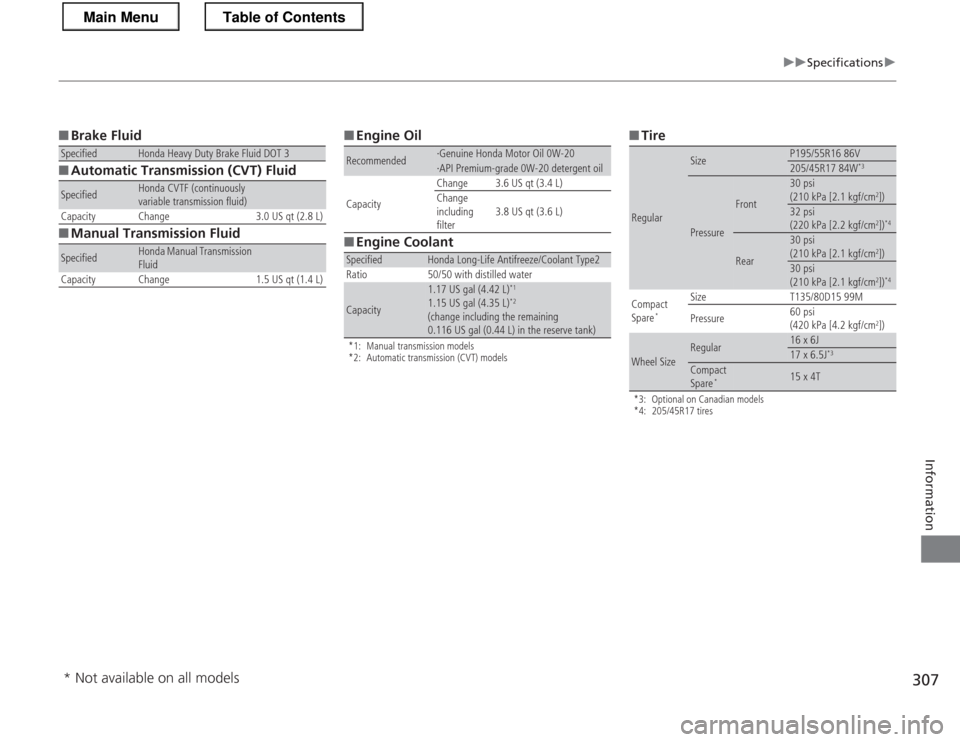
307
uuSpecificationsu
Information
■Brake Fluid
■Automatic Transmission (CVT) Fluid
■Manual Transmission Fluid
SpecifiedHonda Heavy Duty Brake Fluid DOT 3
SpecifiedHonda CVTF (continuously
variable transmission fluid)
Capacity Change 3.0 US qt (2.8 L)
SpecifiedHonda Manual Transmission Fluid
Capacity Change 1.5 US qt (1.4 L)
■Engine Oil
■Engine Coolant
*1: Manual transmission models
*2: Automatic transmission (CVT) models
Recommended
Page 309 of 325

308
Information
Identification Numbers
Vehicle Identification Number (VIN)
Your vehicle has a 17-digit vehicle identification number (VIN) used to register your
vehicle for warranty purposes, and for licensing and insuring your vehicle. See the
image below for the VIN locations.
Engine Number and Transmission Number
See the image below for the locations of your vehicle's engine number and transmission number.
Vehicle Identification Number
Engine Number
Certification Label/
Vehicle Identification Number
Manual Transmission
Number
Automatic Transmission
(CVT) Number IMA Motor Number
Vehicle Identification Number
Main MenuTable of Contents
Page 310 of 325
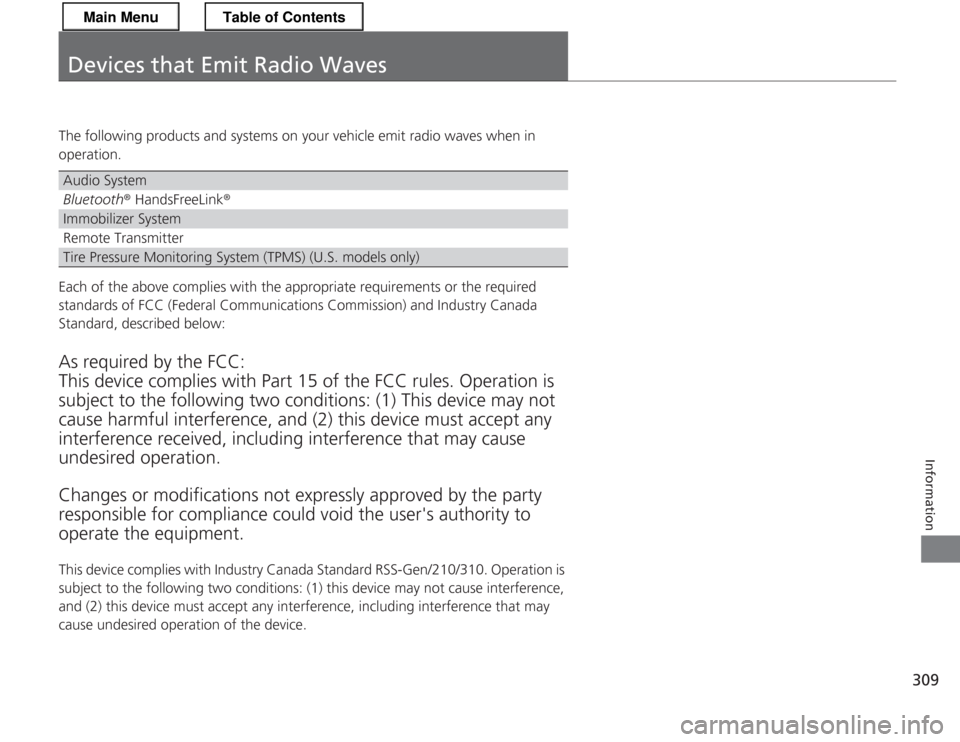
309
Information
Devices that Emit Radio Waves
The following products and systems on your vehicle emit radio waves when in
operation.
Each of the above complies with the appropriate requirements or the required
standards of FCC (Federal Communications Commission) and Industry Canada
Standard, described below: As required by the FCC: This device complies with Part 15 of the FCC rules. Operation is subject to the following two conditions: (1) This device may not
cause harmful interference, and (2) this device must accept any interference received, i ncluding interference that may cause
undesired operation. Changes or mo difications not expressly approved by the party
responsible for compliance could void the user's authority to operate the equipment.
This device complies with Industry Canada Standard RSS-Gen/210/310. Operation is
subject to the following two conditions: (1) this de vice may not cause interference,
and (2) this device must accept any interference, including interference that may
cause undesired operation of the device.
Audio System
Bluetooth ® HandsFreeLink ®
Immobilizer System
Remote Transmitter
Tire Pressure Monitoring System (TPMS) (U.S. models only)
Main MenuTable of Contents